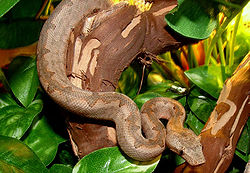Top Qs
Timeline
Chat
Perspective
Candoia
Genus of snakes From Wikipedia, the free encyclopedia
Remove ads
Candoia is a genus of non-venomous boas found mostly in New Guinea, Melanesia, the Solomon Islands and the Maluku Islands in Indonesia. Common names include bevel-nosed boas and keel-scaled boas.[2]
This article needs additional citations for verification. (August 2025) |
Remove ads
Description
The species of the genus Candoia typically have a rounded and heavy body, with a flattened triangular-shaped head and an upturned nose. Colors and patterns vary greatly, but most are various shades of brown to black. Species can vary in adult size from 60 cm (24 in) to 1.8 m (5.9 ft) in total length (tail included). Males are typically smaller than females and can be distinguished by their prominent cloacal spurs.[citation needed]
Remove ads
Distribution and habitat
The species of the genus Candoia are found from Samoa and Tokelau west through Melanesia to New Guinea and the Maluku Islands and the Solomon Islands in Indonesia.[1]
Behavior
All species of Candoia are primarily nocturnal.[citation needed]
Feeding
The primary diet of Candoia species consists of frogs, tadpoles, fish, skinks and other lizards, rodents and birds. Neonates are more inclined to feed on tadpoles, fish and lizard species, with adult specimens of C. aspera, C. p. paulsoni and C. p. tasmai transitioning to larger prey which includes rodents and birds. C. carinata and C. bibroni australis remain focused on lizard, skink and bird prey.[citation needed]
Remove ads
Reproduction
In the species of the genus Candoia, breeding occurs early in the year, typically after rains. Several males will approach and pursue a single female, and mild combat can be observed between the males where they will buck each other off of the desired female. Females seem to only ovulate once every two or three years and give birth to litters averaging 10 or so neonates. The Solomon Island ground boa (C. paulsoni) is an exception, as it is known to have particularly large litters, with the average being 30–40 but as many as 110 on record in captive reproduction.[citation needed]
Remove ads
Captivity
The species of the genus Candoia are frequently imported for the exotic pet trade, but are now being bred in captivity with some regularity by private individuals. Their small size and ease of care make them interesting captives, but wild-caught specimens are not known to acclimate well. The stress of captivity manifests itself in the form of lack of interest in food. Their natural diet often presents a problem for hobbyists mainly familiar with using rodents as food.[citation needed]
Remove ads
Species
Summarize
Perspective
Five species are recognized:[2]
- ) Not including the nominate subspecies.
T') Type species.
Remove ads
Classification
The genus Candoia is traditionally placed in the subfamily Boinae; however, a 2013 study comparing DNA sequences of 12 genes of over 4,000 species supported Candoia as more distantly related, with remaining members of the Boinae being more closely related to the boid subfamily Erycinae; thus Candoia was placed in the newly named subfamily Candoiinae.[5]
References
External links
Further reading
Wikiwand - on
Seamless Wikipedia browsing. On steroids.
Remove ads




